Photographs - Jim and Dorothy
Paterson
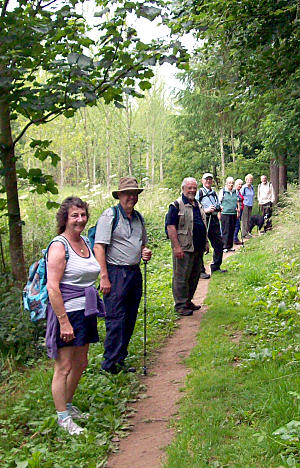 The
2009 sponsored walk got off to a good start. St. Mungo's was also
holding a Strawberry Tea on the same morning, allowing walkers the
opportunity to take refreshments before they set off on the 7.5
mile walk around Pencaitland.
The
2009 sponsored walk got off to a good start. St. Mungo's was also
holding a Strawberry Tea on the same morning, allowing walkers the
opportunity to take refreshments before they set off on the 7.5
mile walk around Pencaitland.
Thirteen gathered outside St. Mungo's and headed off to the
beautifully well kept village of Pencaitland, where Ian Dickson
had put together a route that took us on paths that circled round
the village. The weather was overcast, but warm enough for tee
shirts and shorts for those brave enough. Ideal walking weather. The squally showers encountered on the
drive to Pencaitland never reached us, and we stayed
dry for the whole event.
Setting of form the village centre the path took us along the side
of the Puddle Burn, where soon we came across Winton House.
Winton was built by the Setons following a grant of land by David
I to Phillip de Sayton in 1150. In the sixteenth century, Henry
VIII had Winton burnt in an effort to impress Mary Queen of Scots,
and Mary Seton was later her Lady-in-Waiting. The Seton's tenure
lasted until 1715 when they backed the Jacobites. It was also was
requisitioned by Bonnie Prince Charlie in 1745 when his rebel army
camped on Winton Estate. The Hamilton Nisbets, who bought the
House and Estate, linked it to one of the greatest inheritances of
the 18th and 19th centuries. The furnishings came from all over
Europe and the Turkish Empire and the impressive estates then
included Muirfield and Gullane Links. Today Winton is the family
home of Sir Francis and Lady Ogilvy. [more]
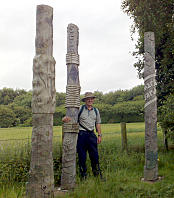 We
pressed on along the bank of the burn for another mile or so
before turning off toward the old railway line. Now used as a
walkway, the single line would have served the Woodhall and
Huntlaw coal pits which were working in the 19th and early 20th
centuries. The walkway is well kept, with many signs detailing
what the walker is passing through, and written in a way to
encourage children as well. We even came across totem poles on the
route, though no one in our group was sure what they signified.
We
pressed on along the bank of the burn for another mile or so
before turning off toward the old railway line. Now used as a
walkway, the single line would have served the Woodhall and
Huntlaw coal pits which were working in the 19th and early 20th
centuries. The walkway is well kept, with many signs detailing
what the walker is passing through, and written in a way to
encourage children as well. We even came across totem poles on the
route, though no one in our group was sure what they signified.
One problem with walking an old railway line route is that trains
prefer to travel in straight lines, and looking along a straight
three quarter mile path is not a great encouragement if you are
walking! However the views from the embankment made up for it as
we headed for Lempock Wells, a former farm now sympathetically
converted to housing, where we joined the main road.
The route took us to the left but the pull to the right was hard
to overcome, as the Glenkinchie Distillery was only a few hundred
yards to the right! Oh well, another day perhaps.
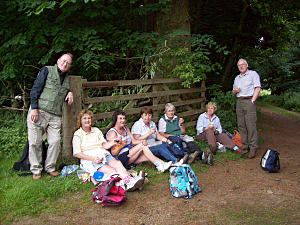 Walking
carefully up the road to West Saltoun we entered the Saltoun
estates through the West Lodge Gate. The rich farming country
around Pencaitland is well served by rivers for irrigation, and we
joined the course of the Birns Water, and stopped nearby Saltoun
Hall for our packed lunch.
Walking
carefully up the road to West Saltoun we entered the Saltoun
estates through the West Lodge Gate. The rich farming country
around Pencaitland is well served by rivers for irrigation, and we
joined the course of the Birns Water, and stopped nearby Saltoun
Hall for our packed lunch.
The home of the Fletcher family since 1643, the current
Saltoun Hall was built in 1820 and sits on the bank of the Birns
Water. The 19th-century designed landscape is laid out to woodland
walks along the river and clumps of trees in the parkland, which
is now farmed. An 18th-century formal parterre garden near the
house was removed by the mid-19th century and is now largely
grassed over, though traces still remain. In 1970 the house and a
small area of garden was sold and converted into flats.
Refuelled and ready to proceed, we headed for the main gates to
the estate at Spilmersford Bridge, which crosses the River Tyne,
passing what appeared to be a small castle tower. In fact it was
the Dovecot for Saltoun Hall, a most grand architectural affair.
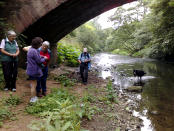 Taking
the path that goes under Spilmersford bridge on the north side of
the Tyne we met the most difficult part of the walk. The pathway
was narrow and heavily overgrown for about a mile and many route
splits had to be checked to ensure we were going in the planned
direction.
Taking
the path that goes under Spilmersford bridge on the north side of
the Tyne we met the most difficult part of the walk. The pathway
was narrow and heavily overgrown for about a mile and many route
splits had to be checked to ensure we were going in the planned
direction.
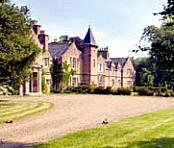 On the south side of the Tyne we passed Tyneholm House, a red
sandstone country house designed in the early part of the 1800's
by the famous pioneer of Scottish Baronial architecture, William
Burn. Today Tyneholm is Henrietta and Edward Gimlette's family
home, restored, renovated, decorated and beautifully furnished,
with two magnificent bedrooms set aside for bed and breakfast
guests. [more]
On the south side of the Tyne we passed Tyneholm House, a red
sandstone country house designed in the early part of the 1800's
by the famous pioneer of Scottish Baronial architecture, William
Burn. Today Tyneholm is Henrietta and Edward Gimlette's family
home, restored, renovated, decorated and beautifully furnished,
with two magnificent bedrooms set aside for bed and breakfast
guests. [more]
We were now on the final leg of the walk which took us back on to
the main road and back to our transport. Many thanks to Ian and
Moira Dickson for selecting and planning this years walk. Always a
good way to enjoy a day out, in the company of like minded people.
Lookout for next years event and join the company, and keep
fit at the same time.
Back
to Top